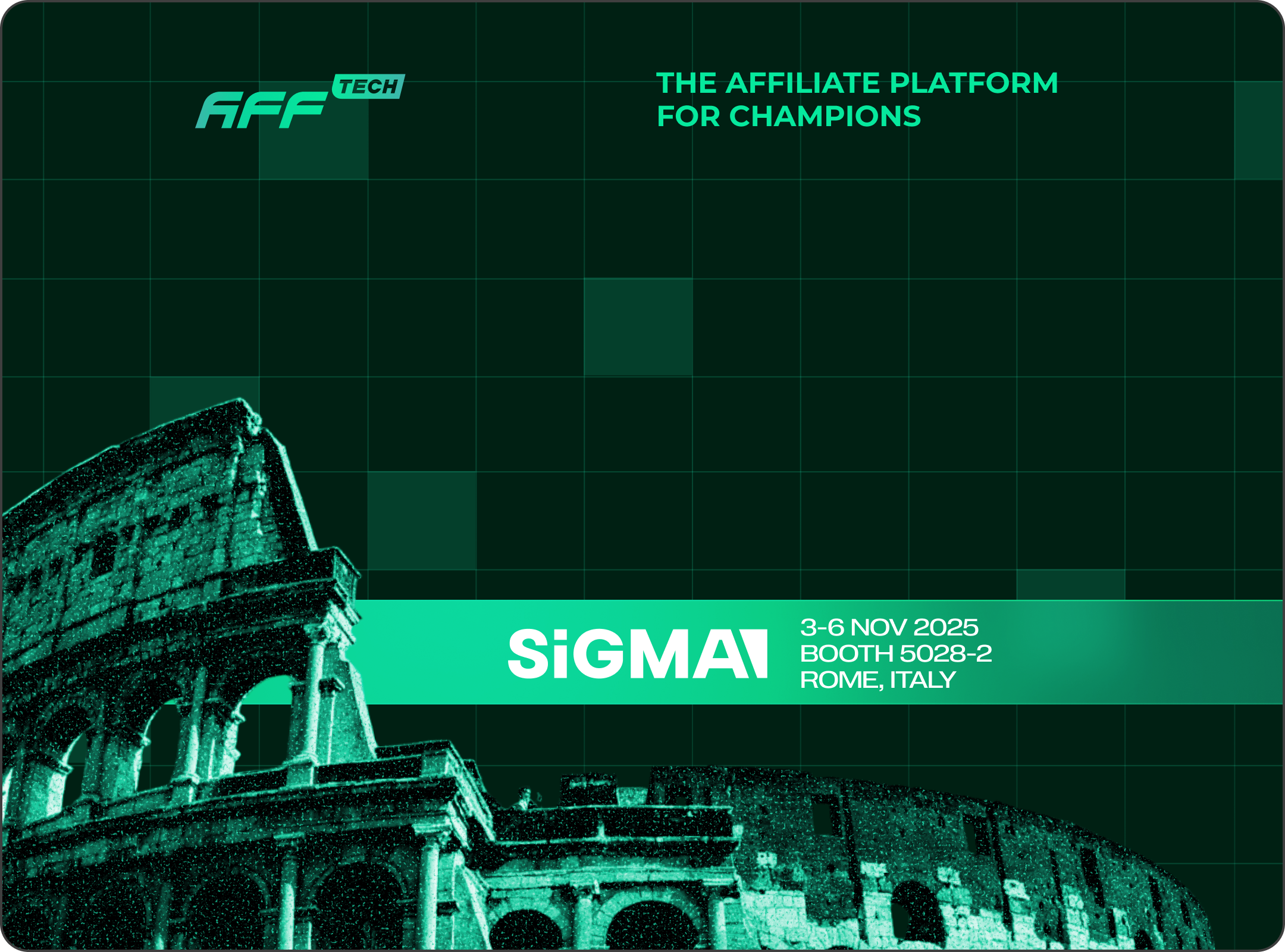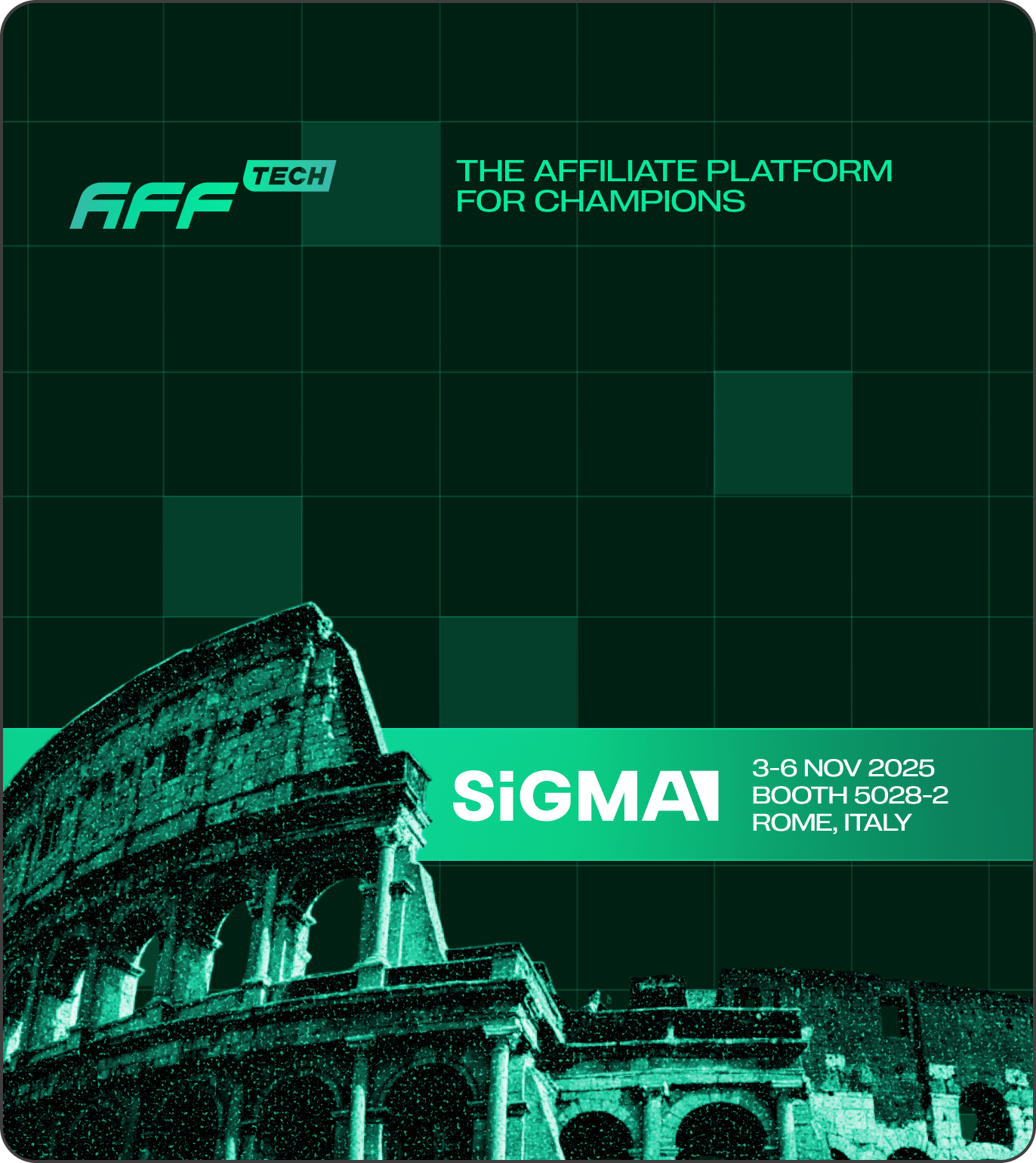
How to Start an iGaming Affiliate Marketing Program in 2026
If there’s a single proof that affiliate marketing is indispensable in iGaming, it’s this: conservatively, around 35% of new online casino players come in through affiliates. That one figure should be enough to show why this channel is a central engine of growth. And that’s the point we’ll be making throughout this guide.
We won’t overwhelm you with charts, forecasts, and other market data; instead, we’ll guide you through the steps of building an affiliate program that suits your platform. We’ll show you how to structure it, set clear objectives and compliance guardrails, select the right technology platform, and choose commission models that fit your goals. You’ll learn how to optimize the program over time, recruit reliable partners, and turn your affiliates into a great source of acquisition and retention.
Why Affiliate Marketing Is Key for iGaming in 2026
You saw the 35% figure above, did you? That’s because affiliate is the most capital-efficient way to buy verified demand in iGaming: you pay for converted, compliant players, not impressions. It scales through specialist partners (review portals, tipsters, streamers) who pre-qualify traffic and localize messaging by market. At the same time, you retain control over unit economics via deal structures (RevShare/CPA/Hybrid) and strict approval rules. Treat it as a managed channel, with targets, governance, and tooling:
| Aspect | Detail |
|---|---|
| Market size trajectory | iGaming affiliate ecosystem ~ $4B (2023) → $7B+ (2025) |
| Channel contribution | Up to 35% of new online casino players via affiliates |
| Spend model | Performance-based: commissions trigger on FTDs/qualified actions, not impressions/clicks |
| Quality & trust | Specialist affiliates (SEO portals, streamers, communities) pre-screen and warm audiences |
| Localization edge | Affiliates adapt to regional rules (RG/KYC ad standards) and player behavior for faster market entry |
| Operator control levers | Commission model, tiering, negative-carryover policy, creative approvals, market allow-lists |
Step 1 – Goals and Strategy for Your Affiliate Program
Every successful affiliate program starts with a clear blueprint. Before you write a single affiliate contract or line of tracking code, align the program with your business goals and constraints. This means defining what success looks like, who you’re targeting, and the rules of engagement upfront. A well-defined strategy will guide all other decisions, from the commission models to offer to partners to recruitment and how you measure performance.
Clear Revenue and Performance Goals
Begin with the end goals: what do you want the affiliate channel to achieve for your iGaming business? Set specific Key Performance Indicators (KPIs) and targets that tie into your broader growth plan.
For example, you aim to acquire X new depositing players per month via affiliates, or have affiliates contribute Y% of your total new sign-ups in 2026. Common goals include:
- Player Acquisition Volume: e.g., “Recruit 500 new FTDs (First-Time Depositors) in Q1 through affiliates.” This ensures the program is driving raw growth in the user base.
- Revenue Contribution: e.g., “Generate 20% of new revenue via the affiliate channel within the first year.” Affiliates often bring high-value players, so define how much Gross Gaming Revenue or Net Gaming Revenue (NGR) you expect from them.
- Cost per Acquisition (CPA) or ROI: e.g., “Maintain an effective CPA of $200 or less per player” (considering commissions paid). Because affiliates are paid a share of revenue or a bounty per player, you can back-calculate whether the program is cost-effective compared to other marketing channels.
- Active Affiliate Partners: e.g., “Onboard 50 active affiliates in target markets.” The number of quality affiliates signed up can be a goal in itself, especially in the early stages.
Tie these goals to time frames and milestones. For instance, you might set a conservative target for the first quarter and ramp up expectations as the program matures.
It’s crucial to ensure your goals are realistic and aligned with your budget. If you promise affiliates very high commissions to drive volume, can your margins support that? Conversely, if you cap the budget too tightly, you may not be able to attract top-tier affiliates.
Additionally, consider the balance between quality and quantity. Is your priority to get high-LTV (Lifetime Value) players even if in smaller volumes (which might imply favoring revenue share deals)? Or do you need sheer volume quickly (perhaps favoring CPA deals for quick sign-ups)? Establishing this focus will inform your commission strategy in Step 3.
In essence, set targets that are SMART (Specific, Measurable, Achievable, Relevant, Time-bound) and make sure they map to your overall P&L projections for 2026.
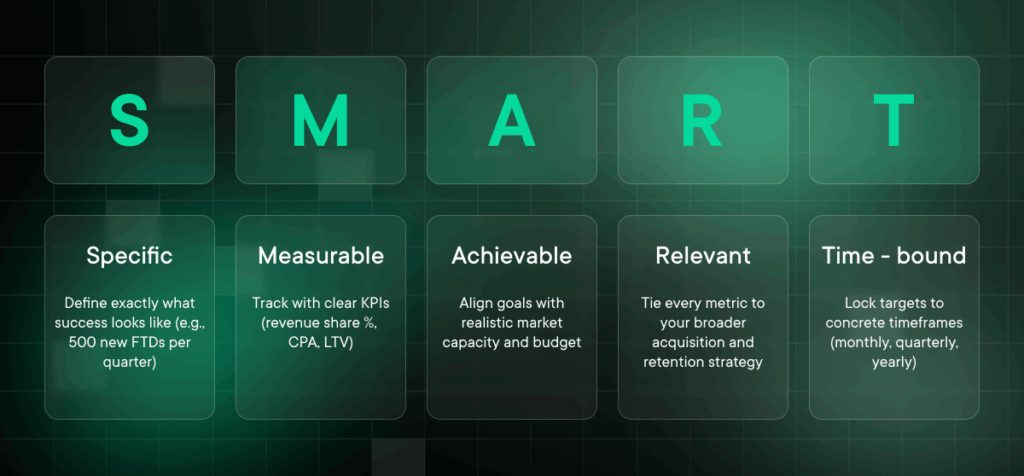
Identify Your Target Audience and Market
An affiliate program works only if it’s aimed at the right players. Define which segments and regions you want to target. This dictates which affiliates to recruit and what content will convert.
Geographic Focus: Target partners active in your licensed markets. A casino launching in Ontario needs Canadian affiliates; expansion into Latin America means Spanish- and Portuguese-speaking partners.
Player Demographics: Match your player type to the corresponding affiliate: slot enthusiasts, VIPs, sports bettors, or poker fans. Younger bettors may come via Twitch or YouTube, while older players respond better to SEO-driven review sites or email marketing.
Product Vertical: Align affiliate expertise with your core offer, e.g., casino review sites for slots, tipsters and bloggers for sports, streamers for poker or esports.
Competitive Edge: Show why players should choose you: unique games, faster payouts, better odds. Share this with your affiliates so they can effectively position your brand.
The result is a clear recruitment brief: a profile of your ideal partners (e.g., Finnish SEO affiliates or UK esports streamers). This ensures player traffic fits your strategy and helps you tap into emerging niches like crypto or live dealer content in 2026.
Ensure Legal Compliance and Regulatory Alignment
In the gambling sector, regulators treat affiliates as an extension of the operator. That means you are ultimately responsible for what your affiliates do in promoting your brand. So from day one, bake legal and regulatory compliance into your program strategy.
Operate only where licensed. Affiliates must promote your brand solely in approved jurisdictions; any breaches can result in fines or risk to their license. However, the exact requirement largely depends on your wider licensing strategy:
- Tier-1 licenses (e.g., UK, Spain): You must follow strict local advertising codes and ensure affiliates do the same.
- Global/Curaçao-style licenses: If you target grey markets, compliance rules are lighter, but you still define boundaries in your affiliate terms.
- No license in a region: You cannot legally accept players or allow affiliates to promote your brand there.
Affiliate licensing. Some regions (e.g., U.S. states like New Jersey, Pennsylvania) require affiliates to hold vendor licenses; the UK is considering stricter oversight. Include compliance clauses in agreements.
Marketing standards. Enforce 18+ and RG disclaimers, ban misleading claims (“free money”), forbid targeting minors, and block spammy or unethical tactics. Affiliates must follow the same ad rules as in-house teams.
Data protection. Adhere to GDPR and local laws; tracking cookies need disclosure, and any shared player data must be handled securely.Ongoing monitoring. Assign a manager to review affiliate activity and audit top partners on a monthly basis. Clear rules and consistent enforcement protect both players and your business.
Step 2- Choose Affiliate Platform Provider
Choosing the right technology platform is the make-or-break decision when setting up your affiliate program. The affiliate software will serve as the backbone, tracking all clicks and conversions, calculating commissions, and providing an interface for you and your partners to manage the program. A flimsy solution, on the other hand, can lead to tracking errors, lost revenue, or even fraud. Here’s how to navigate the selection:
Key Features to Look For in Affiliate Software
Based on industry best practices and the expectations of modern affiliates, make sure any platform you consider offers the following core features:
Tracking & Analytics: Must log clicks, registrations, FTDs, deposits, and revenue in real time across devices. Granular campaign data (campaign, creative, LTV, conversion funnels) supports optimization.
Commission Flexibility: Support RevShare, CPA, Hybrid, tiered deals, and brand-specific terms. Handle negative carryover per your policy.
Fraud & Compliance: Spot duplicate accounts, suspicious traffic, and bonus abuse. Provide compliance checks (e.g., mandatory disclaimers).
Payments: Automate commission calculations, support multi-currency payouts, and integrate with payment providers. Batch payments and withdrawal requests keep affiliates satisfied.
Integration: Ensure secure API or module integration with your iGaming backend for reliable data flow.
Dashboard & UX: Affiliates require self-service portals for statistics, creatives, and links; admins need straightforward onboarding, approvals, and reporting.
Scalability: Handle multiple brands and traffic spikes, with reliable uptime and vendor support.
Reporting: Enable API/CSV exports and flexible reports to integrate with your BI stack.
Vendor neutrality and support: Ensure that whichever platform you choose comes from a vendor that offers timely support and regular updates; you don’t want a critical tracking bug during a major tournament and have no one to call.
Some companies even provide an account manager to assist with setup and best practices, which can be very helpful if you’re new to running affiliate software.
Comparing Affiliate Platform Options
The iGaming industry has a range of affiliate software providers, each with its own approach. Below is a comparison of some of the popular solutions and their characteristics to help guide your decision:
| Platform | Approach & Notable Features |
| Aff.Tech (by GR8 Tech) | Proprietary affiliate management platform; 220K+ Active Partners, 10M+ leads; supports RevShare, CPA, Hybrid; smart negative carryover management; advanced fraud detection; real-time reporting with API/CSV export; automated payouts; traffic segmentation by geo/device/language; mobile-optimized dashboard; multi-brand support; granular permissions and compliance controls |
| MyAffiliates | Standalone affiliate software; flexible commission models; detailed reporting; widely used (~16% operators); customizable but requires hosting/support. |
| Income Access | Established platform (Paysafe); strong tracking and reporting; affiliate network option; multi-channel support; enterprise-level complexity and cost. |
| Affilka (SoftSwiss) | Module integrated with SoftSwiss; seamless data flow; crypto/fiat payouts; multi-brand support. |
| NetRefer | Legacy enterprise system; detailed dashboards; multi-tier commissions; used by large operators; high setup and maintenance needs. |
Step 3—Affiliate Commission Model
Designing your commission model is where the rubber meets the road for your affiliate program’s economics. The incentive structure you offer will directly impact what types of affiliates sign up and how they promote your brand. In iGaming, several commission models are standard: Revenue Share, CPA (Cost Per Acquisition), and Hybrid deals are the big three, each with its pros and cons.
There’s also the less common fixed-fee or flat sponsorship model (where you pay for placement or exposure), but most programs revolve around the core three. Choosing the right model (or mix of models) comes down to aligning with your acquisition goals from Step 1 and the kind of affiliates you’re targeting. Let’s break down each:
Revenue Share Model
A Revenue Share (RevShare) model means you pay affiliates a percentage of the gambling revenue generated by the players they refer. In practice, this usually means a cut of the Net Gaming Revenue (typically the players’ losses minus any bonuses, taxes, and fees). However, some agreements might base it on Gross Revenue for simplicity. This commission is recurring as long as the player remains active (often for the lifetime of the player, or sometimes for a capped duration, such as 1-2 years).
Pros:
- Attracts partners skilled at acquiring high-LTV users.
- Aligns incentives: affiliates profit only if players stay and generate revenue.
- No upfront cost per player; payouts scale with actual earnings.
Cons:
- Requires trust in accurate reporting and clear terms (tiers, caps, carryover).
- Long-term liability: Lifetime deals can erode margins as affiliates continue to collect.
- Variable costs: one jackpot win can wipe out NGR; high activity means high commissions.
| Dimension | What It Means in RevShare | Typical Values / Options | Operator Considerations | Example / Notes |
| Revenue basis | % paid on revenue generated by referred players | NGR (common) or GGR (rare) | Define formula in contract; avoid ambiguity | NGR = GGR − bonuses − provider fees − PSP fees − taxes − jackpots |
| NGR formula components | Items deducted before commission | Bonuses, free bets/FS cost; provider fees; PSP/chargebacks; taxes; jackpots | List each line item and the % calculation method | Bonuses at face value or effective cost? Provider fee 10–20% GGR? |
| Commission rate | % of NGR (or GGR) paid to affiliate | Casino/Poker: 25–60% NGR; Sports: 15–35% NGR | Set by market, brand strength, and quality | Super affiliates negotiate top tiers; new partners start lower |
| Payout duration | How long commissions accrue | Lifetime (common) or capped (6–24 months) | Lifetime grows tail cost; caps reduce liability | 12-month cap clause common |
| Negative carryover | Do negative balances carry over to the next month? | No carryover; with carryover; high-roller quarantine | High-roller quarantine prevents margin distortion | Reset rules; define thresholds |
| Tiering | Rate increases with volume or revenue | FTD or NGR-based tiers | Set fair thresholds; apply monthly | Apply non-retro; encourage scale |
| Cross-product bundling | Combine casino/sports/poker earnings | Bundled or unbundled by product | Bundling can dilute payouts if one vertical has a negative | Clarify per-vertical calculation |
| Cross-brand policy | Earnings across multiple brands | Pooled or brand-specific | Pooled may offset negatives/positives; transparency key | Disclose clearly in T&Cs |
| Attribution | How players are credited | Last-click (common), first-click, cookie window 30–90 days | Align with platform tracking; avoid disputes | Document re-attribution rules |
| Qualification | When a player counts for revshare | KYC passed; first deposit; wagering threshold | Prevent low-intent/bonus abuse; define handling | Define self-exclusion/cooling-off handling |
| Compliance | Marketing rules affiliates must follow | 18+/RG labels; banned claims; geo allow-list; source restrictions | Operator liable; audit content; enforce | Termination/clawback for breaches |
| Fraud controls | Prevent fake/abusive traffic | Device fingerprinting, duplicate detection, and anomalous CR flags | Protects margin; reduces disputes | Withhold pending investigation per SLA |
| Reporting | Data shared with affiliates | Daily/real-time stats; player cohorts; itemized deductions | Transparency builds trust; avoid shaving claims | API/CSV export; timezone alignment |
| Payouts | How/when affiliates are paid | Monthly/bi-weekly; bank/e-wallet/crypto; multi-currency | Clear minimums, fees, FX policy | Net-15/Net-30 common; batch payments |
| Clawbacks | When earnings are reversed | Fraud, chargebacks, KYC fail, self-exclusion within X days | Define window and evidence standard | CPA/revshare clawback within 60 days |
| Rate guards | Protect against runaway cost | Caps per player, declining tiers, time caps | Balance incentive vs. margin | Whale clause: max% % above threshold |
| Use cases | Where RevShare fits best | Content/SEO sites, communities, streamers | Favors quality & retention | Aligns incentives toward LTV |
| Risks | Cost behavior over time | Rising tail cost; jackpot variance; reporting disputes | Mitigate via caps, HR quarantine, and audits | Communicate policies upfront |
| Operator levers | Contract knobs to tune economics | Basis (NGR/GGR), tiers, carryover, caps, bundling, duration | Choose a mix per market and traffic quality | Revisit quarterly with data |
| Example—low LTV | Player NGR $200 total | 30% of $200 = $60 commission | Cost tracks value; limited downside | Affiliate earns $60 total |
| Example—high LTV | Player NGR $5,000 total | 30% of $5,000 = $1,500 commission | High tail cost; still profitable if margins allow | Affiliate earns $1,500 total |
| Effective CPA view | Implied cost per new depositor | Eff. CPA = (Avg LTV × revshare %) | Compare to paid media CPA | If LTV $600 and 30%, CPA = $180 |
For affiliates, the attractiveness of RevShare lies in its uncapped upside: one referred whale could generate thousands of dollars in commissions. For operators, the advantage is quality control: affiliates have a reason to send players who stick around (they won’t get anything from one-and-done bonus hunters). Many operators consider RevShare deals as a way to build a “partner” mindset: the affiliate essentially shares the player’s lifetime value, which encourages them to send engaged players and even re-engage them through content.
However, keep in mind potential pitfalls: If not managed, rev share deals can linger even if affiliates stop actively promoting you (they still collect on past referrals). Also, watch out for affiliates “poaching” players from each other or from your direct channel (attributing players who might have signed up anyway). A solid platform and clear rules (such as last-click attribution windows and no self-referrals by affiliate owners) help manage that.
💡Use RevShare models if your priority is long-term revenue and you’re confident in your product’s retention. It’s a “pay as you earn” model – not cheap, but aligned with your success.
Cost-Per-Acquisition (CPA) Model
A CPA model means you pay a one-time flat fee for each player who meets a predefined conversion criterion. In iGaming, the typical trigger is a New Depositing Customer: you might pay, say, $100 for every referred player who makes their first deposit (the “First Time Depositor” metric). Some CPA deals pay for simpler actions, such as sign-up or registration, but these are rare in regulated markets because a sign-up alone doesn’t guarantee revenue.
More commonly, it’s the first deposit, or the first bet/wager of a certain amount. Once that action is completed and verified, you owe the affiliate the fixed bounty, and no further payments will be made for that player thereafter.
Pros:
- Predictable costs: fixed payout per player simplifies budgeting.
- Immediate affiliate reward → attracts high-volume traffic sources.
- Profitable if CPA < average player LTV.
- No ongoing liability; accounting stays simple.
Cons:
- Front-loaded cost before player value is proven.
- Loss risk if CPA > actual player LTV.
- Incentivizes quantity over quality, with a risk of one-time depositors.
- Higher fraud/bonus abuse potential; requires strict qualifiers and monitoring.
| Dimension | What It Means in CPA | Typical Values / Options | Operator Considerations | Example / Notes |
| Basis of payout | Flat fee per qualified player action | Usually FTD (first deposit); sometimes first bet | Define clear qualifying criteria; ensure action reflects real value | Rarely sign up only in regulated markets (too low value). |
| Trigger criteria | An event that generates a payout | First deposit, first bet/wager, deposit of the minimum amount | Set thresholds to filter bonus hunters and fraud | E.g., CPA is valid only if $20+ deposit and 1 bet are placed. |
| Commission structure | One-time payment | Paid once per qualified player; no recurring income | Simplifies accounting, no long-term liability | Affiliate stops earning after the first action. |
| Typical rates | Flat fee per FTD | Casino: $50–$250; Sportsbook: $50–$150; U.S. regulated: $300+ | Benchmark vs. player LTV in each market | High-intent traffic (e.g., UK SEO sites) can demand £ 200 or more. |
| Quality control | Ensuring genuine players | Set qualifiers: deposit minimums, play requirements | Reduces fraud and low-value traffic | Block payouts for chargebacks and self-exclusions. |
| Fraud risk | Affiliates gaming the system | Incentivized sign-ups, bonus abuse, fake accounts | Use fraud detection and short-term monitoring | Spot $10 deposit + immediate withdrawal patterns. |
| Affiliate appeal | Cash flow and simplicity | Attractive to PPC/media buyers, email marketers | Offers a wide reach but may reduce long-term player quality | Volume-heavy affiliates often prefer CPA over RevShare. |
| ROI management | Aligning CPA to player value | CPA must stay below average player LTV | Regularly reassess market rates and retention | If avg. LTV = $500, safe CPA ≤ $200. |
| Use cases | Best scenarios for CPA | Fast scaling, short-term user growth, and market entry | Balance with RevShare/Hybrid for sustainability | Launching in a new regulated state with growth targets. |
CPA deals make sense if you need to scale your user base quickly and have the cash to support upfront payouts. New market launches often rely on CPA-heavy campaigns to onboard a large number of players rapidly (affiliates will push hard if the bounty is attractive). It’s also useful if you want to cap your cost per player firmly, knowing you’ll never pay more than that fixed amount for any one user. Operators with shorter-term goals (e.g., preparing for an IPO or acquisition and seeking large user numbers) may lean on CPAs. Additionally, some affiliates simply prefer CPAs for cash flow reasons, so offering it can broaden your pool of partners.
But you do need to define “qualified player” clearly in your terms. For instance, you might say the CPA is earned only if the player deposits at least $20 and places X number of bets, etc. Have an agreed-upon time window for conversion (e.g., the player must deposit within 30 days of sign-up for the affiliate to receive credit). Additionally, determine how you will handle chargebacks or self-exclusions: if a player reverses their deposit or is found to be underage and you are required to refund, do you recoup the CPA? Many programs have a clause to adjust or retract CPA in cases of fraud or refund.
💡CPA is a straightforward “You bring a player, we pay you once” deal. It provides immediate acquisition at a known cost, which is excellent as long as that cost is aligned with your player value. Use it to complement RevShare or to entice affiliates who otherwise wouldn’t work with you. However, keep a close eye on player quality and be prepared to adjust the terms as needed.
Hybrid Model
As the name suggests, a Hybrid model combines elements of both RevShare and CPA. In a hybrid deal, the affiliate receives a smaller CPA upfront for each player and also a lower-percentage revenue share on the backend for that player’s lifetime. For example, an operator might offer a hybrid commission, such as “$50 CPA + 20% RevShare,” for each qualifying player. This gives the affiliate an immediate reward and a taste of long-term earnings.
Pros:
- Balances risk: operators cover some upfront cost, affiliates share long-term player value.
- Attractive to affiliates who want both immediate payout and ongoing earnings.
- More cost-efficient than high CPA or high RevShare alone if players perform well.
- Signals operator confidence and strengthens partnerships.
Cons:
- Requires careful calibration of CPA and RevShare percentages to stay sustainable.
- The total cost can exceed the pure CPA if players have short lifetimes.
- Total cost can exceed pure RevShare if players become high-value “whales.”
- More complex to model and manage than single-structure deals.
| Dimension | What It Means in Hybrid | Typical Values / Options | Operator Considerations | Example / Notes |
| Basis of payout | Mix of CPA + RevShare | Smaller CPA upfront + lower % of NGR ongoing | Balance between cash flow (CPA) and retention incentive (RevShare) | E.g., $50 CPA + 20% RevShare |
| Commission structure | Dual-component deal | CPA covers acquisition effort; RevShare rewards long-term value | Each part is lower than standalone deals | If CPA norm = $100, RevShare 30%, hybrid might be $50 + 15% |
| Pros (Operator) | Aligns incentives while limiting exposure | Lower upfront than pure CPA; lower tail % than full RevShare | Reduces risk of overpaying on whales or flops | Affiliate has ‘skin in the game’ on quality |
| Pros (Affiliate) | Best of both: upfront cash + ongoing revenue | Secures baseline even if player churns | Appeals to content affiliates and smaller partners | Quick cash flow + passive long-tail earnings |
| Cost dynamics | Risk-sharing between operator and affiliate | Hybrid costs more than pure CPA for low-LTV players, more than pure RevShare for high-LTV players | Run scenario modeling (e.g., $500 / $1000 net player value) | Smooths extreme outcomes, keeps costs predictable |
| Typical rates | Calibrated below standalone offers | CPA: ~$30–$75 + RevShare: 10–20% | Varies by vertical and market | Instead of $100 CPA or 30% RevShare, offer $50 + 15% |
| Risk profile | Balanced but not minimal | Operator pays something regardless of LTV; affiliate earns less lifetime than on full RevShare | Sustainable only with accurate LTV models | Avoid over-generosity that mimics high CPA + high RevShare |
| Affiliate appeal | Strong | Popular with affiliates needing both stability and upside | Encourages trust in the operator’s retention ability | Seen as a ‘serious program’ signal |
| Use cases | When to deploy a hybrid | Launching in new markets, attracting fence-sitting affiliates | Ideal when unsure of affiliate traffic quality | Middle ground between risk-heavy CPA and RevShare |
Operators can use hybrid deals as a sweet spot to attract affiliates who are undecided between wanting immediate payouts and long-term value. By paying a modest CPA, you cover the affiliate’s initial acquisition costs or effort, which motivates them to send traffic. However, by keeping a revenue share component, you ensure they still have a stake in the game for player quality. It’s essentially sharing the risk: you, the operator, take on some upfront cost, and the affiliate, in return, accepts a lower lifetime cut than they would on pure RevShare.
Affiliates, in turn, get the best of both: some quick cash flow per conversion and still the chance to earn more if the players stick around. This is particularly appealing to many content affiliates or smaller affiliates who might not survive waiting months for rev share to accrue. It also appeals to affiliates wary of an operator’s retention: they secure at least a baseline payment even if the player doesn’t remain, but if they do, they enjoy ongoing income.
💡Often, top affiliates might request a hybrid approach because they know their traffic is good, but they also want immediate returns. It’s also useful when entering a new partnership: you might offer a hybrid model for an initial period to build trust and then perhaps transition to a full RevShare once the affiliate sees the long-term value. You can also use hybrid deals selectively, e.g., only for affiliates who consistently bring a minimum quality (so that you’re not paying CPA for junk traffic).
Step 4 – Affiliates Recruitment and Onboarding
With your strategy in place, platform ready, and commission model defined, the next crucial step is finding the right affiliate partners and motivating them to produce. Remember that a few high-performing affiliates can outdo dozens of average ones. Recruitment and onboarding involve a mix of marketing outreach, relationship building, and providing support. Let’s break it down:
Identifying Top Affiliate Partners
Start by defining who your ideal affiliates are, based on your target markets and audience (as outlined in Step 1). In iGaming, some familiar affiliate archetypes include:
- SEO-driven review sites that capture high-intent search traffic and demand competitive RevShare or Hybrid deals;
- Content creators and influencers on Twitch, YouTube, or social media who bring engaged audiences and often ask for custom or sponsorship-style arrangements.
- Bloggers and tipsters who provide niche, targeted traffic via CPA or RevShare;
- Community managers running Telegram, Discord, or Facebook groups who can generate bursts of activity around key events;
- Media buyers and arbitrage affiliates who act like performance marketers, investing in ads and requiring solid CPA or Hybrid payouts;
- Sub-affiliate networks that extend reach by pooling smaller partners under one umbrella, though with less transparency and control.
To find these affiliates, leverage multiple channels:
- Industry Directories and Platforms: Sites like AffPapa, Affiliate Guard Dog, GPWA forums, or even LinkedIn groups can help identify known affiliates. There are directories where affiliates list themselves, or operators can post that they have a new program.
- Affiliate Conferences and Events: The iGaming affiliate world has several big conferences (e.g., SiGMA, iGB Affiliate events in London, Amsterdam, etc.). Attending these or at least browsing their attendee lists can connect you with top affiliate businesses.
- Competitive Analysis: See where your competitors are getting affiliate traffic. Search for your competitor’s brands and look at who’s promoting them. If specific sites rank well for them, those sites are affiliates you can approach. Additionally, some affiliate sites publicly list their partners or include “Join this program” sections that provide clues.
- Personal Outreach: Don’t shy away from emailing or messaging an affiliate site owner directly. Craft a pitch highlighting what your program offers (high commission, new product, unique market, etc.) and why it’s worth their attention. Affiliates get many offers, so be clear how you stand out (e.g., “We’re offering an exclusive 30% lifetime rev share for partners who join our launch” or “We have a conversion rate of 40% sign-up to deposit thanks to our instant KYC and local payment options – meaning more $$$ for you”). Show that you understand their audience: “Noticed you focus on crypto casinos – our platform accepts 5 cryptocurrencies and we have a provably fair game selection, which could resonate with your readers.”
- Affiliate Managers or Agencies: If you have a budget, you could hire an affiliate manager with an existing network of contacts, or even use an agency that helps recruit affiliates for new programs. They can accelerate connections, though at a cost or retainer.
💡However, remember that affiliates will also be evaluating you. The best affiliates can choose which brands to promote. They’ll look at your product (is your casino or sportsbook appealing?), your reputation (do you pay on time? any negative news?), and the earnings potential. Make sure you have a compelling story: if you’re a new brand, maybe you have a unique game or bonus that will excite players; if you’re established, emphasize your conversion rates or retention, which means more rev share for them.
Offer Competitive Commissions and Incentives
Affiliates go where earnings are strongest, so your offer must be competitive without undermining margins, here are a few boilerplate suggestions before we move on to marketing and support for your beloved affiliates:
- Benchmark against market norms (e.g., 25–35% RevShare or $100 CPA in casino/sportsbook) and avoid looking weak.
- Keep in mind that tiered RevShare (e.g., 25% base, scaling to 40% for higher FTDs) incentivizes growth, while attractive CPA terms or faster payouts can win over volume-driven partners.
- Short-term promos (+5% for three months, cash bonuses for hitting targets) add momentum.
- For key affiliates, negotiate custom deals or exclusive player bonuses that boost conversions. Present offers clearly and highlight your program’s strengths, like higher conversion rates or reliable payments.
- Remember always that competitive terms open the door; trust and consistent delivery keep affiliates loyal.
Provide Marketing Resources and Support
Think of your affiliates as an extension of your marketing team. To set them up for success (which in turn means success for you), you need to equip and support them much like you would an internal team, especially at the beginning of a partnership: the easier you make it for an affiliate to promote your brand, the faster you’ll see results. Key areas to focus on are creative assets, tracking tools, and personal support:
Ready-to-Use Marketing Assets
Prepare a library of promotional materials that affiliates can use:
- Visuals. This typically includes banners of various standard sizes (JPEG/GIF/HTML5 banners for web in standard dimensions, such as 300×250 and 728×90), logo files, and possibly short video ads or GIFs for those who can utilize animated media.
- SEO. Also consider providing landing page URLs tailored for affiliates – for example, a special landing page that says “Welcome [SiteName] visitors! 100% bonus up to $200 awaits…” which can improve conversion from that affiliate’s traffic. You might create different landing pages focusing on different USPs (e.g., sports vs. casino, or one highlighting a major tournament, etc.) and let affiliates choose.
- CRM/Retention. Email templates or content snippets can also be helpful: some affiliates have mailing lists or write blog posts, so providing them with pre-written promotional copy (such as a paragraph about your brand or a new promotion) can ensure accurate messaging.
- Compliance. Ensure that everything complies with regulations (e.g., include the required disclaimers in banners).
All these assets should be easily accessible through your affiliate platform or via a shared drive. Keeping creatives fresh is important: update banners for new games, seasonal promotions, or just to prevent “banner fatigue.” Affiliates appreciate seeing new content to use, as it can increase their click-through rates.
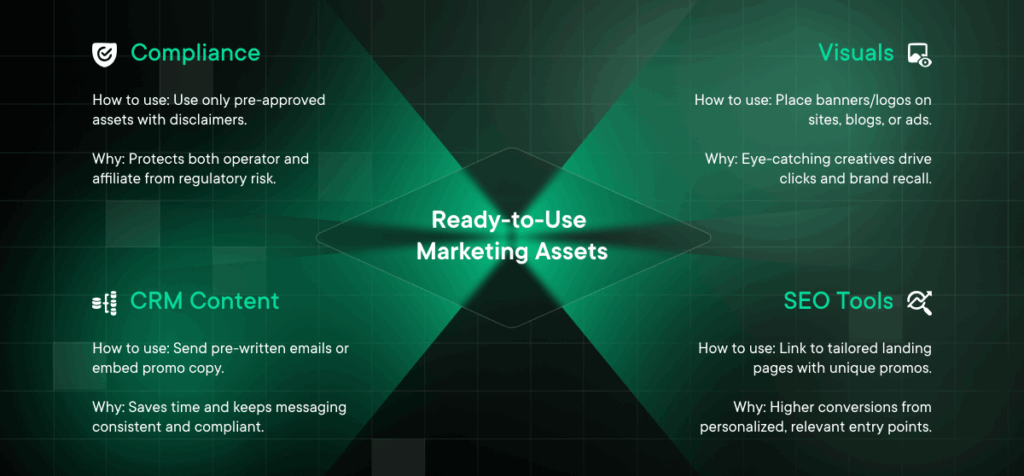
Deep Linking and Tracking Tools
The affiliate platform should allow affiliates to create deep links to any page on your site (so they’re not forced always to send traffic to the homepage). Encourage affiliates to link to relevant content. More advanced affiliates will use sub-IDs or tracking parameters to segment their traffic; ensure your platform supports that (most do) and educate affiliates on how to use them.
Training and Best Practices
Especially if you bring on newer affiliates (or staff who are new to affiliate management), sharing knowledge is vital. For affiliates, you may create a simple “Affiliate Program Guide” PDF that explains how to obtain links, how tracking works, when payments occur, and who to contact with questions, among other details.
Also include any compliance guidelines in this guide—what they must do (e.g., show 18+ logo, etc.) and must not do (e.g., bidding on your brand name in Google Ads if you forbid that, or using certain words that violate regulations). This sets expectations clearly.
For affiliates looking to improve, consider sharing performance tips, such as: “Affiliates who place our banner near their top-fold content see 30% higher click rates,” or “Players from your region respond well to our live casino offering – try mentioning our live dealer games, which have high engagement.” If you have data insights (such as certain hours of the day converting better or specific bonus offers working best), sharing that information can help affiliates optimize their campaigns in ways that benefit both of you.
Dedicated Affiliate Manager & Communication
Ensure affiliates understand that there’s a real person behind the program. As the operator, assign a dedicated affiliate manager or team who will serve as the primary point of contact.
Onboarding Process
When a new affiliate signs up to your program, have a smooth onboarding: a welcome email that reiterates the main program info and links to resources; if it’s a high-potential affiliate, perhaps a personal call or meeting to walk them through everything.
Verify that their tracking works (perhaps by conducting a test registration via their link) so the affiliate is confident. It’s wise to manually approve affiliates (to filter out fraudulent or irrelevant ones), but do so quickly; nobody likes to wait weeks. While vetting, also ensure you collect necessary info for due diligence (some jurisdictions require you to KYC your affiliates or have them sign responsible marketing agreements).
Technical Support
Occasionally, affiliates may have technical questions or issues, such as tracking links not working or stats not updating. Be ready to troubleshoot. It might involve your platform provider if it’s a bug, or simply guiding the affiliate (e.g., “you need to disable an ad blocker to see the tracking pixel fire,” etc.).
Step 5 – Your Affiliate Program Scaling and Optimization
Once your affiliate program is up and running with a roster of partners, the work is far from over. In fact, the focus now shifts to continuous optimization and scaling the program for improved performance.
This involves measuring the right metrics, refining strategies through testing, and nurturing the affiliate relationships you’ve built. A complacent program will plateau; an actively managed program can grow exponentially, even turning into your primary acquisition channel. Step 5 covers how to keep improving and expanding:
Track Performance with Key KPIs
Data is your compass for the affiliate program. You need to diligently track and analyze a set of Key Performance Indicators (KPIs) to understand how the program is performing and where adjustments are needed. Essential KPIs and metrics include:
| KPI / Metric | Definition | Operator Considerations |
| Number of New Depositing Players (NDPs or FTDs) | Count of first-time depositors from affiliates in a given period; key volume metric. | Break down by affiliate to see top contributors; guides partner management. |
| Deposits and Revenue from Affiliate Channel | Total deposits and NGR from affiliate-referred players show the revenue contribution of affiliates. | Benchmark affiliate-driven revenue as % of overall; casinos often see up to ~35%. |
| Affiliate Payouts and Cost | Total commissions paid to affiliates; track as absolute and as % of NGR. | Monitor trends; rising payout % may indicate declining player value or unsustainable commissions. |
| Effective CPA (Cost per Acquisition) | Average cost per player = commissions paid / number of new players; compare with other channels. | Helps assess the sustainability of deals and ensures the CPA is aligned with LTV. |
| Player Quality Metrics | Player LTV, conversion rates, and retention indicate the quality and long-term value of affiliate traffic. | Spot high-quality vs. low-quality affiliates; optimize landing pages or traffic sources. |
| Active Affiliates | Number of affiliates actively driving players during a period; compare active versus inactive affiliates. | High dormant rates may require outreach or re-engagement tactics. |
| Top Affiliate Share | Percentage of traffic or revenue concentrated in top affiliates; measures dependency risk. | Diversify if overly dependent on a few affiliates; mitigate the risk of losing key partners. |
| Fraud and Churn Metrics | Chargebacks, self-exclusions, fraud incidents; track to identify red-flag affiliates. | Keep voided commissions to a minimum; enforce compliance fairly. |
| ROI per Affiliate | Revenue generated vs. commissions paid; measure profitability per affiliate. | Investigate affiliates with ROI <100%; determine if a temporary or structural issue. |
| Growth Trend | Month-over-month changes in affiliate channel metrics; forecast trends and seasonal impacts. | Utilize trends to inform planning of recruitment efforts or commission adjustments. |
Having these KPIs allows you to identify bottlenecks or opportunities. For example:
- Indicator: many clicks but low conversions on one affiliate. Solution: the landing page needs optimization for that audience.
- Indicator: lots of NDCs but low revenue. Solution: bonus abusers are signing up, taking a bonus, and not gambling beyond it. Adjust your bonus or affiliate terms.
The data should drive strategic conversations: e.g., “Affiliate segment X (like streamers) has lower volume but higher value players. Let’s recruit more of those,” or “Our cost per acquisition from affiliates in Germany is creeping up, perhaps renegotiate rates or focus on better traffic sources.”
Regular reporting is key. Set up a dashboard or weekly report to review these KPIs. Many affiliate managers produce a monthly performance report for internal stakeholders, highlighting the affiliate program’s contributions and any issues that may have arisen. This keeps the program visible as an asset to the company and helps secure support for expansion (like budget for events or bonuses).
A/B Testing and Improvements
Optimization in affiliate marketing isn’t just about affiliates doing better. As an operator, you should constantly test and refine elements of your program to improve results. Key practices include:
- Test creatives & landing pages: Compare variations to boost affiliate traffic conversion; share insights with partners.
- Experiment with offers & bonuses: Rotate promos (deposit match vs. free bet) and track uptake by region or audience.
- Trial commission tweaks: Temporarily adjust rates or CPA boosts during events; measure traffic lift vs. cost.
- Run affiliate contests: Incentivize sign-ups with tiered rewards and evaluate whether engagement broadens beyond top affiliates.
- Optimize communication: A/B test newsletters, frequency, or webinars to find the right cadence for engagement.
- Pilot new markets/products: Use small affiliate groups to test entry strategies and gather early feedback.
The mantra is continuous improvement. Keep a log of the changes you implemented and their outcomes. Over time, these incremental improvements compound.
For instance, optimizing landing pages and funnels for affiliate traffic improves conversions by 10%. Refined commission tiers attract 15% more traffic from mid-level affiliates, and cracking down on low-quality sources improves player values by 5%. Together, these improvements make the program much stronger overall.
Don’t forget to involve affiliates in the optimization process. Ask top partners for feedback. They might tell you, “Hey, your site’s sign-up flow is clunky on mobile, people drop off.” That’s valuable feedback you can relay to your product team to improve, boosting conversions across all channels. Affiliates often have a pulse on user behavior because they see across multiple operators where they send traffic. If they say “Brand X gets better conversion because of Y feature,” consider that seriously. It’s like having a free consulting input.
💡Celebrate improvements. If a tweak led to better results, share that success: “Thanks to your feedback, we changed our registration form and saw a 20% lift in conversions, meaning you earn more. We’ll continue to optimize to improve our partnership.” It shows affiliates that you’re committed to mutual success and encourages them to continue providing input.
Fostering Strong Affiliate Relationships
At the heart of a sustainable affiliate program is the relationship you maintain with your partners. Affiliates are more likely to stick with you, promote you over others, and prioritize your offers if they feel valued and see you as a long-term partner rather than just another advertiser. So:
- Share roadmaps, launches, and even problems early.
- Act on affiliate suggestions (e.g., faster payouts, new payment methods) and notify them when improvements are live.
- Give VIP affiliates early access to promos, custom campaigns, or perks. Keep long-tail affiliates (smaller partners in your program who drive little traffic individually, but collectively represent a meaningful share of volume) engaged with automated updates.
- Reward affiliates who scale with better terms; clearly explain any adjustments if conditions change.
- Enforce rules fairly with evidence; correct minor missteps with dialogue before penalties.
- Use CRM/notes to segment affiliates (VIP, growth, long-tail); assign managers consistently.
- Create a portal or group for affiliates to share insights and get quick answers.
Conclusion
Building an affiliate program in iGaming is ultimately about creating a stable system of trust and reciprocity. Affiliates are partners who choose to align with your brand because they see value in both the relationship and the revenue.
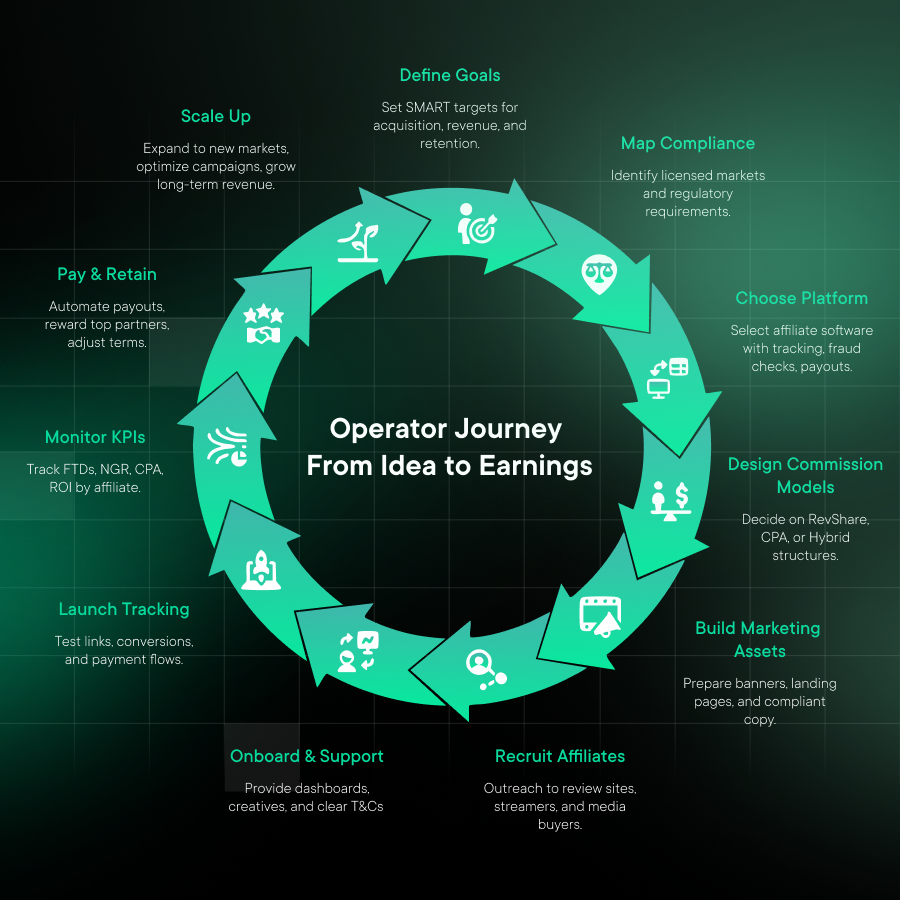
When treated with respect, kept informed, and rewarded fairly, affiliates become advocates who remain loyal to you, even when competitors offer higher commissions. That loyalty, multiplied across dozens or hundreds of relationships, is what turns affiliate marketing into a long-term growth engine. The challenge lies in the fact that it requires continuous effort, including compliance oversight, data-driven optimization, and the patience to cultivate partnerships that may take months to fully mature.
But for operators willing to invest in both the mechanics and the human element, affiliate marketing becomes a resilient network that grows with you, adapts with you, and can carry your brand further than any one campaign or market push ever could.
FAQ
What are the benefits of starting an affiliate program for my business?
A well-structured affiliate marketing program provides operators with scalable acquisition and controlled spend. With platforms like Aff.Tech, you can track ROI in real time, manage commissions flexibly, and automate payouts. This turns affiliate programs into a predictable channel for growth, lowering upfront costs while aligning partner incentives with long-term revenue.
How do affiliate programs help increase player retention in iGaming?
Aff.Tech allows segmentation by market, device, or campaign, ensuring affiliates target high-value cohorts. By rewarding loyalty through commission structures, our affiliate marketing process prioritizes long-term player quality, improving retention across casino, sportsbook, and poker verticals.
What are the common mistakes when starting an iGaming affiliate program?
Operators often rush to start an affiliate marketing business without implementing compliance safeguards, negotiating flexible deals, or establishing clear KPIs. Another mistake is ignoring fraud detection: fake sign-ups drain budgets. Finally, failing to support partners with transparent reporting or resources makes them leave. Building a sustainable affiliate system means investing in compliance, data, and communication from day one.
What features should I look for in affiliate tracking software?
Modern affiliate program marketing requires more than basic tracking. Aff.Tech provides real-time postbacks, API integration, flexible commission models, fraud alerts, and automated payments. Mobile-optimized dashboards and customizable reporting let operators and affiliates act on insights instantly. These features make our marketing affiliate program transparent, efficient, and scalable.
How can I ensure my affiliate program is secure and resistant to fraud?
Security is critical in any affiliate marketing program. Aff.Tech offers two-factor authentication, role-based permissions, encryption, and automated fraud detection tools. Suspicious traffic, duplicate accounts, or bonus abuse can be flagged and blocked in real time. With granular access controls, you can protect data and ensure only valid activity is rewarded in your affiliate business.
What KPIs should I monitor for affiliate performance?
Key metrics in a marketing affiliate program include new depositing players (FTDs), NGR contribution, effective CPA, and ROI per affiliate. Platforms like Aff.Tech also let you track retention rates and fraud indicators. Monitoring these ensures affiliates deliver genuine, profitable traffic, helping you refine commission structures and improve the overall affiliate system.
Are there any restrictions on promoting iGaming brands online?
Yes, regulated markets impose strict rules on affiliate marketing. Affiliates must target only licensed jurisdictions and adhere to advertising standards, including the use of 18+ disclaimers and responsible gambling messages, as outlined by Aff.Tech operators can enforce compliance by setting guidelines and auditing materials, reducing the risk of fines or reputational damage.
How do I measure the ROI of my affiliate program?
ROI in an affiliate program is measured by comparing commission payouts against net gaming revenue from referred players. Aff.Tech delivers real-time reporting, allowing you to calculate effective CPA and player lifetime value. This visibility helps determine whether to join affiliate program models like RevShare, CPA, or Hybrid, and ensures your affiliate marketing spend aligns with your profit goals.
POWER YOUR AFFILIATE PROGRAM WITH AFF.TECH





